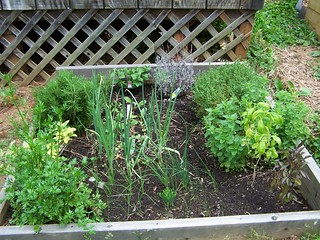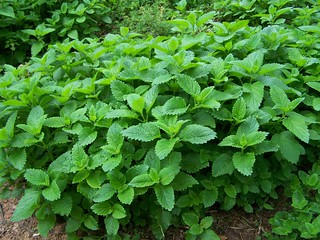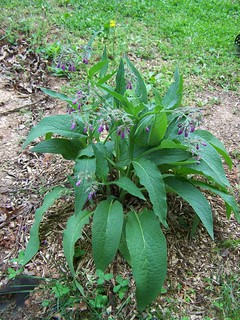I’ve been meaning to write an article about common herbal garden items that have healthful benefits beyond their vitamins and minerals. Now that spring is upon us and the garden is coming along nicely it’s time I got around to that.

Growing herbs has many advantages and takes very little space. You can grow 16 different herbs in a 4’ x 4’ raised bed garden. You may need to pot some plants: like mint, which is wildly invasive, but you can set the pot down into your bed if you want to keep them all in one place.
Parsley
Parsley has been cultivated for 2,000 years, and was used medicinally long before that. In fact, in ancient times parsley was regarded as sacred and was used to decorate tombs.
This leafy green is not just an attractive garnish; it’s chock full of essential vitamins. Just two tablespoons of parsley provide over 150% of the daily recommended value of vitamin K. It’s also rich in vitamins A & C, and is an important source of antioxidants. But what it less known is that the oil which is concentrated in the leaves and roots of parsley is high in apiol and myristicin, which are natural diuretics.
A study published in the “Journal of Ethnopharmacology” in March 2002 gave rats parsley seed extract and found that this significantly increased urine flow. This would benefit anyone fighting kidney stones.
Drinking a tea made from dried parsley leaves or root three times a day can help keep your kidneys clear. Steep 2 grams (.07 ounces) of dried parsley in 150 ml (5.07 US fl ounces) of hot water.
Fine Print
Be careful when using large amounts of parsley if you are pregnant, as both apiol and myristicin can cause uterine contractions, and myristicin may cause an increase in fetal heart rate. If you are taking lithium, do not use parsley without medical supervision. Other possible side effects of excessive use of parsley oil include headaches, loss of balance, convulsions and renal failure.[1]
Herbal Teas
Several herbs that are essential seasonings for your cooking also deserve a place in your herb bed for their medicinal value. Physician Andrew Weil maintains a list of healthful herbs and their uses at his website, www.DrWeil.com. In regard to dried herbs, Dr. Weil recommends:
- Don’t buy whole dried herbs from bins or jars in stores. These loose herbs are probably worthless because dried plants deteriorate upon exposure to air, light and moisture and the more finely chopped the plant parts are, the faster they lose their desirable qualities.
- Avoid encapsulated powdered herbs because when plants are ground into powders, they’re exposed to oxidation which causes them to deteriorate.
- Buy reputable brands that advertise the purity of their ingredients.
- The best herbal medicines are those you grow yourself. Maintaining a personal herb garden can ensure freshness and quality.
To brew a tea, add 1 teaspoon of dried — or 3 teaspoons of fresh — herbs to 1 cup of boiled water; steep several minutes, then remove the herbs. This is much simplified if you use an infuser.
Here are some of my favorites:
Thyme Tea
Thyme tea soothes a throat which is sore from coughing and has anti-viral properties.
Chamomile Tea
Is a great before-bed tea because it calms and relaxes. Parents report that it helps to sooth cranky kids when they’re feverish.
Lemon Balm Tea
 Counters headaches and can be used to mask the undesirable flavor of other medicinal teas. Steeped in a stronger solution, lemon balm can be used as a topical antiseptic for minor injuries.
Counters headaches and can be used to mask the undesirable flavor of other medicinal teas. Steeped in a stronger solution, lemon balm can be used as a topical antiseptic for minor injuries.
Sage Tea
Can sooth and heal mouth sores and bleeding gums after dental work.
Mint Tea
Is good at soothing an upset stomach – peppermint is especially good at this.
Comfrey
 I grow Comfrey as a compost accelerator, but it has healthful benefits as well. Comfrey contains the small organic molecule: allantoin, which stimulates cell growth and suppresses inflammation.[4] Scientists and physicians agree that the use of Comfrey should be restricted to topical use, and should never be ingested. Comfrey salve or a strong solution can be used to treat diaper rash, eczema, psoriasis, and burns. Here is a recipe for making your own Comfrey salve. She adds plantain, but you won’t need to cultivate those in your garden, just check your yard!
I grow Comfrey as a compost accelerator, but it has healthful benefits as well. Comfrey contains the small organic molecule: allantoin, which stimulates cell growth and suppresses inflammation.[4] Scientists and physicians agree that the use of Comfrey should be restricted to topical use, and should never be ingested. Comfrey salve or a strong solution can be used to treat diaper rash, eczema, psoriasis, and burns. Here is a recipe for making your own Comfrey salve. She adds plantain, but you won’t need to cultivate those in your garden, just check your yard!
Pineapple
While most of us won’t be growing pineapple in our gardens, it is worth mentioning because of its great benefit in fighting inflammation. Fresh pineapple contains bromelain, a powerful anti-inflammatory. This is helpful in fighting the stiffness and pain of arthritis and reducing C.O.P.D. problems . Taking turmeric with the pineapple increases the benefit in regard to C.O.P.D.
Only fresh pineapple will do – cooking or processing (canning) the pineapple kills the bromelain and its benefits. The bromelain is concentrated in the pineapple core, so don’t toss that out. Mix chunks with water and pulse it in your blender to make a healthy juice, or just sit and gnaw on a core chunk. The fiber will do you good as well.
Considerations:
As noted above, you will get the most from herbal cures by snipping off what you need and using them fresh from the garden. If you must dry them for storage, dry the leaves whole, seal them into air tight bags or vacuum packs and store them away from direct light. Some can be successfully frozen as fresh leaves.
As with any form of self-medication, consider your situation first. If you are being treated for a serious medical condition, and taking prescription drugs, check with your doctor before taking herbal remedies. “Natural” and “Organic” are not guarantees of being harmless or that they won’t interact with other substances.
Read more articles like this at Of Mice and Mountain Men Medicinal Plants and Herbal Remedies by Nina Nelson

good article, lots of great info